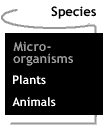
Wetlands:
Species--Microorganisms
Microorganisms are the smallest, most basic lifeforms to inhabit wetlands. They range from single-celled organisms to colonies of single cells. Although many are invisible to the naked eye, microorganisms perform a variety of important roles in wetlands. One of these roles is that of
primary producer. Many of these microorganisms, such as blue-green algae, trap and store sunlight in the form of chemical energy. All organisms need energy in order to live, but most are incapable of directly using energy from the sun. They rely on the blue-green algae as food and an indirect source of solar energy. Another role of microorganisms is that of
decomposer. Some microorganisms recycle nutrients by breaking down dead organic material into its simpler elements; this is a large part of the decaying process.
Common types of wetland microorganisms
include:
protists organisms that are single-celled and eukaryotic (which means that their genetic material is contained in a nucleus); for example, plankton, algae, and amoebas. Photo: Amoeba. Photo courtesy of Frank Dazzo, Center for Microbial Ecology, MSU.
bacteria organisms that are single-celled and prokaryotic (which means that their genetic material is not contained in a nucleus); for example, anabaena and gleocapsa.
Visit the Microbe Zoo for more images and information on some of these wetlands microorganisms.
Overview
..|..
Species
..|..
Functions..
..|..
Management
Microorganisms
/ Plants / Animals
Glossary
..|..
Related
Links
..|..
References
|..PBL
Model
Home ..|.. Teacher Pages ..|.. Modules & Activities
HTML code by Chris
Kreger
Maintained by ETE Team
Last updated
April 28, 2005
Some images © 2004 www.clipart.com
Privacy Statement and Copyright © 1997-2004 by Wheeling Jesuit University/NASA-supported Classroom of the Future. All rights reserved.
Center for Educational Technologies, Circuit Board/Apple graphic logo, and COTF Classroom of the Future logo are registered trademarks of Wheeling Jesuit University.

